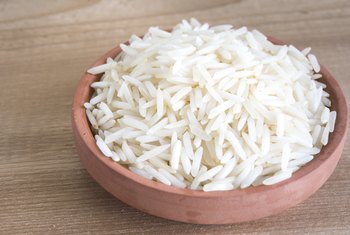The Resistant Starch in White Rice

Found in white rice and other starchy foods, resistant starch acts like beneficial fiber in your digestive system. More than 70 percent of rice consumed in the United States is white rice, according to the U.S. Department of Agriculture, making the refined grain a major source of resistant starch in U.S. diets. The small amount of resistant starch in white rice does not seem to make up for some negative health effects the rice may have, though.
About Resistant Starch
Starch exists in plant foods as long chains of glucose, your body’s primary source of energy. Resistant starch is a type of starch that is indigestible by human enzymes. Bypassing digestion, it travels to the colon essentially unchanged, where bacteria ferment it into compounds that exert health benefits on your body. Legumes, tubers, cereals, fruits, vegetables and other plant foods are good sources of resistant starch.
Resistant Starch Benefits
Resistant starch improves bone density by enhancing the absorption of calcium and other minerals in adolescents and postmenopausal women, according to the Academy of Nutrition and Dietetics -- formerly known as the American Dietetic Association. The laxative effect of resistant starch increases the ease and frequency of stools, easing constipation. If you have diabetes, the non-digestible fiber may reduce your post-meal blood sugar by slowing the absorption of glucose into your bloodstream, according to the organization.
About White Rice
Refined white rice is made by removing fiber, iron and B vitamins from brown rice to produce a more finely textured starch with longer shelf life. Some of the vitamins are later added back to the finished product, a process known as enrichment. White rice is fortified with folic acid to prevent folate deficiency. A 3.5-ounce serving of cooked white rice contains up to 3.7 grams of resistant starch, according to researchers in a 2008 article published in the “Journal of the American Dietetic Association.”
White Rice Caveats
White rice consumption is associated with higher risk of type 2 diabetes in U.S. men and women, according to research published in the “Archives of Internal Medicine” in 2010. The risk decreases by 16 percent when white rice is replaced with the same amount of brown rice, note the authors. Some foods in the U.S. food supply, including rice, are potential sources of arsenic, warns the Environmental Protection Agency. The typical U.S. diet exposes Americans to one-fifth the maximum arsenic level deemed safe by the EPA. Include brown rice as part of a diet rich in whole grains and choose refined grains sparingly.
No comments:
Post a Comment